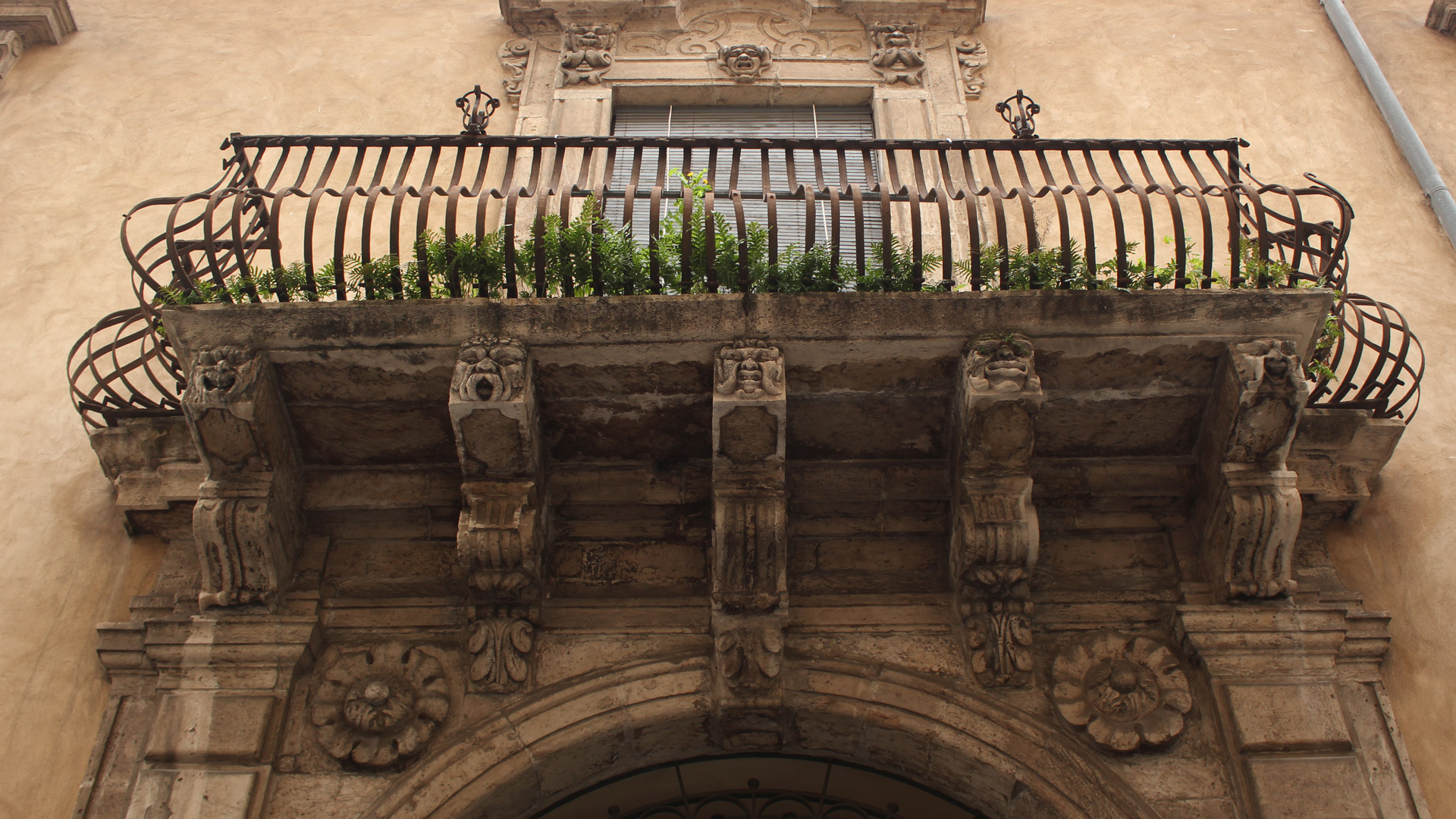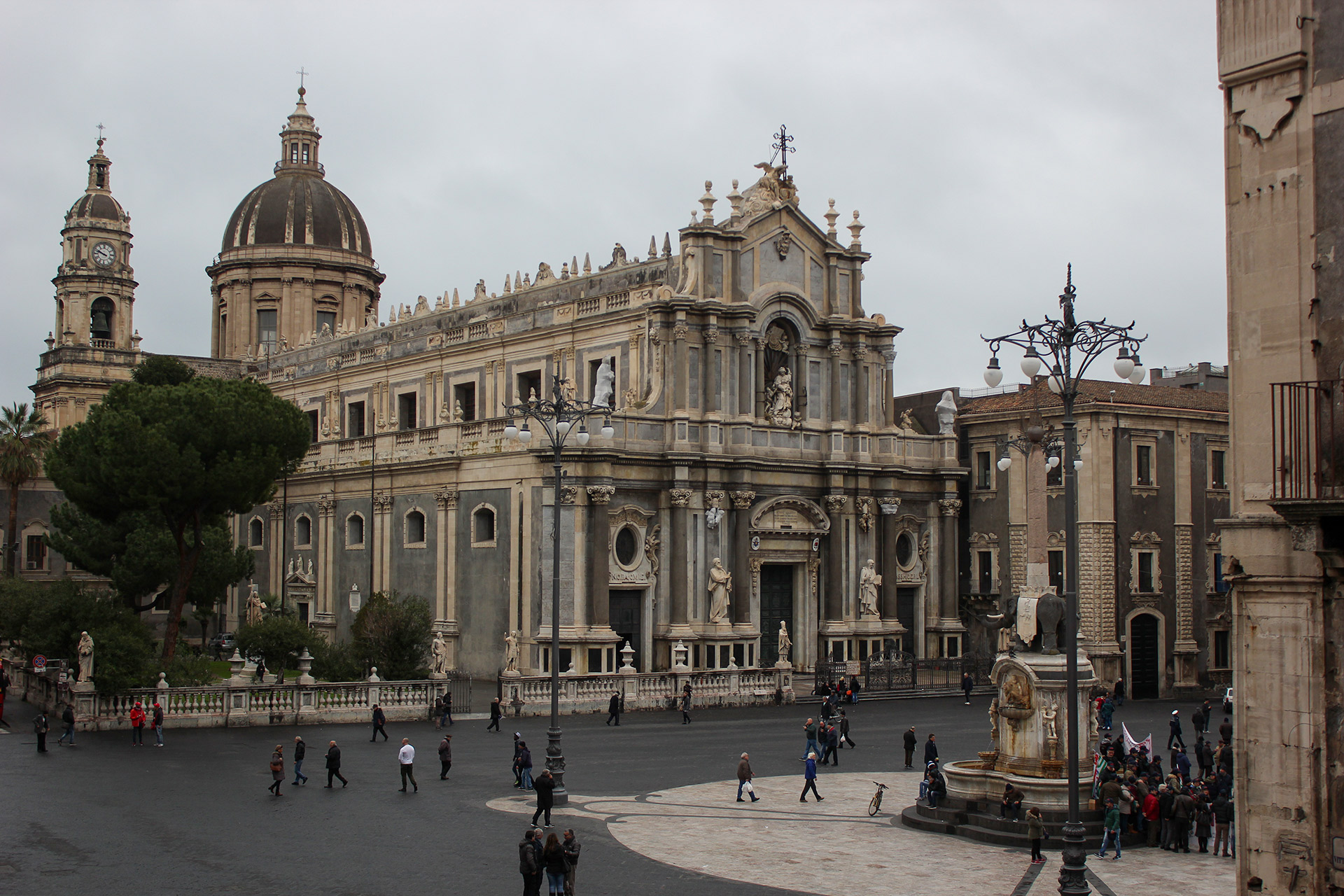An architectural jewel: Palazzo Marletta may be considered as the emblem of that Baroque architectural style which has left a strong historical mark on the evolution of the city of Catania, from period that followed the earthquake of 1693 to the present day.
Palazzo Marletta
cradle of Baroque
temple of culture
Years
history
Palazzo Marletta, formerly an ancient family residence and then Albergo Bella Catania, transformed into a Luxury House Hotel, with 300 years of history
The history of
Palazzo Marletta
The Framing
The block in which Palazzo Marletta is inserted overlooks Piazza Duomo, and it is ordered by Via Roccaforte, north, by Via Vittorio Emanuele II, south, by Via San Giuseppe al Duomo, west and by Via Erasmo Merletta, east. The building has two exposed prospects on Via Vittorio Emanuele II, south, and on Via Erasmo Merletta, east; the north and the east side are bordering the adjacent palaces Internally, the building takes light by a court, accessible from the ground floor. The artefact has been subject to internal splitting operations, over time, obtaining more independent spaces.
Rules and restrictions
The building is historical and monumental, and therefore bound by the terms by L.1089/1939 con D.D.G. n. 6196 del 30.05.2011. The palace was built at the behest of the Marletta family in the, once called, district “Fori Lunaris”, at the corner between via Erasmo Merletta and via Vittorio
Emanuele II, according to the building regulations, established on June 28th 1694, by the Catania city council, which prescribed maximum height as single-storey buildings, after the sad experience of the earthquake of January 1693.
Historical description
A view of the Piazza Duomo by Leon du Fourny, operating in Catania at the end of the eighteenth century, shows the original prospectus as described in the carving assignment given to Benedict’s Alonzo, in 1694. In fact, in the archival deeds, master Alonzo di Benedetto, lapidor incisor of Catania, among the expense notes, he declares to have received from Vincenzo Marletta, on August 06th 1696 “the amount of onze 52.7.10, of which onzie … for black stone carving of the stores, onze … for the two counters arches in the “cantonera”, and doors and windows above the said arches, onze … for white carving of two “cantonere”, onze … for two doors in white stone, two windows and two “dimmezzo” doors and onze … for all the arches of the stores made of white stone and master.
The importance of the building is of historical-artistic interest, as an example of the eighteenth-century architecture, Work of the architect Francesco Battaglia, As well as of a building complying with the rules established at the end of the seventeenth century, about the height of the buildings after the earthquake of 1693.

Architectural description
The angular prospect between via Marletta and via Vittorio Emanuele, represents the focal point of the building, highlighted by the white stone ashlar, in contrast to the lava stone base, strengthened from the balcony with railing in iron goose breast, supported by shelves also in white stone variously molded. The entrance portal on Via Marletta n°7 has an arched opening surrounded by white stone jambs, flanked sideways from the smooth ashlar and five molded shelves frontally decorated in bas-relief by allegorical figures that support the balcony with railing in iron goose breast. The overlying opening, surmounted by bas-relief decorations, presents white stone jambs. The architect Lo Jacono, formerly Superintendent, imagined subsequent interventions on the external facade, realized by Francesco Battaglia.
Some interiors, including the main salon, have stuccoes and decorations of the end of the eighteenth century and the beginning of the nineteenth century. In other spaces, especially on the ground floor, there are nowad a ys mezzanines, built before the fifties of the last century and used for commercial purpose. The building presents a partial elevation from the twentieth century, and interiors maintenance interventions And the change of intended use that did not alter the original distribution. The noble floor that can be reached from the main staircase is composed of various rooms whit fresco and vaulted ceiling.
Inside the noble floor there are two communication ladders, that lead to the mezzanine rooms made for the servitude, severing the two wings of the building, and witnessing the probable and original use of the noble floor by two families.
The rooms of the noble floor are 25 sqm approximately, surmounted by canes and plaster pavilion vaults with various decorations, and the balconies are exposed on Piazza Duomo. The traditional majolica floors are made up of hand-decorated terracotta tiles.
An architectural jewel
Palazzo Marletta may be considered as the emblem of that Baroque architectural style which has left a strong historical mark on the evolution of the city of Catania, from period that followed the earthquake of 1693 to the present day. The palace represents Catania in all its Baroque tradition, both for its exterior and for the beauty it encloses within its walls. It is an architectural jewel set in the historical panorama of Catania.
Piazza Duomo
Baroque Outlines
The Baroque arrived in Catania really late, compared to the rest of Italy, but it has found fertile ground in the reconstruction of the city. The first era started just after the 1693 earthquake and it ends with the coming of Vaccarini; it is distinguished by its pompous, bright and jagged shape.
Decorative and significant elements
The decorations on the windows of the buildings are strongly evident and resume floral patterns; the bosses, they are shaped, squared, faceted in cushion or diamond; the strong and robust pilasters; the abundance of the acanthus leaves in incisive bas-relief; the shelves of the balconies concluded by caricature masks.
The Square
Preserving its dominant role since Roman times, Piazza Duomo, in the great project of the reconstruction after the earthquake of 1693, doubled its size, thanks to the Bishop Riggio’s ambition who demanded and obtained more space for the religious overlooking buildings.
At that time, the square was the one that resulted from the reforms for demolitions of houses, and from the restorations of the boundary walls ; but the square in spite of everything, still resulted small.
The Urban Fabric
The two blocks, constituting the south side of the square, did not arise on the line of today’s Municipal Building, but four meters forward, at least. In fact, in the excavations performed, there were exposed the thresholds of the buildings erected before 1693, just four meters ahead of the line held today from the houses of via Vittorio Emanuele.
In the continuum of the urban fabric, in which the contrast between the fullness of the palaces and the emptiness of the streets and of the squares, is resolved in a balance of equivalence, the central fountain signs a role dedicated to the social aggregation, representation, without adding the role of space catalyst element.









